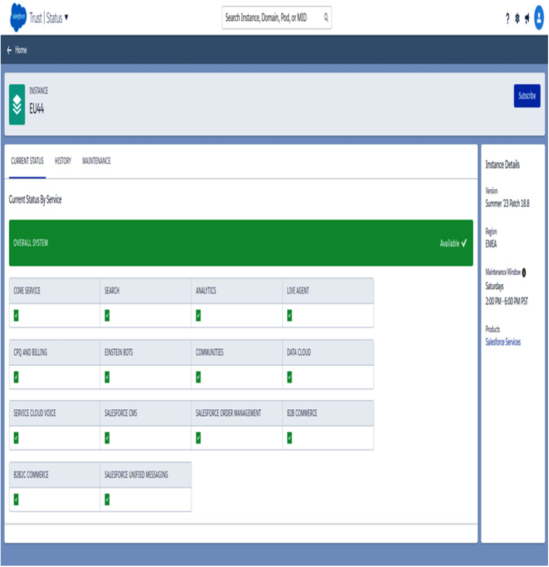Ever wonder when your Salesforce org will get new features? You can check it out at https://status.salesforce.com/instances. Just navigate to the Maintenance tab and search for release in the search bar. You may search there for major release names and their dates.
- Version: The current Salesforce version on which your Salesforce instance (so, also org) operates; for example, Summer ’23 Patch 18.8 (but if you are reading this book in the year 2077, it may be written Summer ’77 there).
- Region: The region where your instance data is located; for example, EMEA
- Maintenances Window data: The time when Salesforce is planning to do some work related to the instance, such as implementing new features or doing some patches. There may be some access interruptions during this time:

Figure 2.11: Salesforce Trust maintenance status
Tip
From time to time, Salesforce may go a bit crazy and stop working for a few minutes. This occurs very, very rarely, but of course, it can happen. If this occurs, do not panic, and refrain from blaming yourself for any potential mistake. Instead, visit the https://status.salesforce.com/ page to check if there are any current issues or maintenance activities related to the instance where your Salesforce org is hosted.
Summary
Congratulations! You have just come through the second chapter of this book! I hope you stay motivated and ready for the next chapter. For now, let’s summarize the chapter that you have just finished.
We explored the concept of multi-tenancy, where a single software instance served multiple clients. We examined the challenges faced by Salesforce in maintaining boundaries and making updates. This chapter shed light on why Salesforce employed a multi-tenant architecture. Thanks to comparison to a hotel where guests shared common resources but had isolated, private rooms, you should now remember better what multi-tenant means.
Next, we unraveled the notion of Salesforce orgs, their origins, and the various types in use. We learned about the lifecycle of an org and received practical best practices to address user and administrative concerns effectively.
In the final section of this chapter, we introduced Salesforce PODs, which are essentially server locations for Salesforce data. These instances can host multiple distinct Salesforce orgs, each with its own security measures, ensuring data isolation and protection. This chapter provided a solid foundation for understanding Salesforce’s architecture and organization.
In the next chapter, you will learn about the Salesforce data model and data management.
